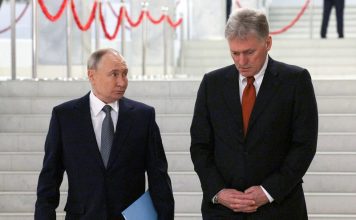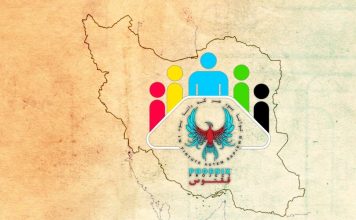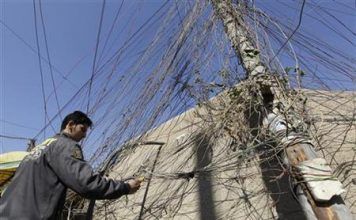By Kayhan Life Staff
The new version of Iran’s “Hijab and Chastity Law” will impose stiffer penalties on women who fail to respect the mandatory hijab, Hossein Jalali, a Majlis (Iranian Parliament) deputy, said on March 26.
Mr. Jalali, who represents the Rafsanjan electoral district (capital of the southeastern province of Kerman), explained that the latest proposal calls for canceling the passports and driving licenses of hijab violators, and fining them between 500,000 tomans ($9.86) and 3 billion tomans ($58,000). (The conversions are based on the current exchange rate of 51,650 tomans to a U.S. dollar.)
[aesop_image img=”https://kayhanlife.com/wp-content/uploads/2023/03/hejab-shahyad.jpg” panorama=”off” credit=”KL./” align=”center” lightbox=”on” captionsrc=”custom” captionposition=”left” revealfx=”off” overlay_revealfx=”off”]
“The proposal results from 300 meetings with the Supreme Council of the Cultural Revolution and the Supreme National Security Council,” Jalali said at a press conference in Anar. “Hijab violators will be fined between $9.86 and $58,650. Celebrities and bloggers with large following on [social media] channels could have their passports and driving licenses canceled and denied access to the internet.”
“Under the proposal, seven groups will be penalized: internet users, celebrities, people traveling in a car, or people in public places such as restaurants, offices, government organizations, universities, education centers, airports, terminals, and streets,” Jalali, a member of the Cultural Commission of the Majlis, explained.
Jalali noted that the new “smart” proposal “bans physical confrontation with the hijab violators,” adding, “the government must propose a bill in the next week or two, so it can be passed and ratified.”
“God willing, the measure will be enacted,” he added.
The Majlis has informed Iran’s Supreme Leader, Ayatollah Ali Khamenei, and the Judiciary about the new proposal.
Under the new bill, police cannot use physical force against hijab violators. This is likely to be in response to the nationwide protests sparked by the death of Mahsa (Zhina) Amini while in the custody of the morality police on Sept. 16 in Tehran.
Ms. Amini, a Kurdish woman from Saqqez, in the northwestern province of Kurdistan, was arrested three days earlier for allegedly violating the Hijab Law, and fell into a coma and later died because of severe head injuries she suffered in police custody.
The protests that followed Amini’s death gained massive international support and quickly morphed into a “national revolution” with the slogan “woman, life, freedom.”
In comments reported by the Tehran-based Entekhab newspaper on July 6, Iranian President Ebrahim Raisi ordered the Supreme Council of the Cultural Revolution to enforce the “Hijab and Chastity Law.”
“Regarding hijab and chastity, we urge the Supreme Council of the Cultural Revolution and other institutions to enforce the law passed by the Majlis, and the law passed by the Supreme Council of the Cultural Revolution in 2005,” Entekhab quoted President Raisi as saying.
Since coming into office, President Raisi and his hardline government have set out to restrict women’s civil rights and freedoms.
Iran to Resume Cellphone Warning to Hijab Violators, Police Spokesperson Says
On March 14, the Cultural Commission of the Majlis submitted a report on ways to “curb improper hijab,” drafted by the Interior Ministry, the moral propriety board, and other hijab-related organizations.
“The enemies know only too well that the tremendous progress made by the Islamic Revolution in the past decades has been achieved in the shadow of a correct and irreplaceable education of this land’s youths and through the efforts of Iranian women and mothers,” the report said.
“The enemies’ principal goal is to derail this great achievement by changing the Iranian and Islamic lifestyle and targeting the most precious moral aspect of Iranian society, i.e., chastity and hijab,” it warned. “Therefore, they use various schemes and tools to tarnish Iranian women’s image and impose the vulgar Western culture on the country.”
“The current laws are weak and do not address today’s moral issues facing our society,” the report argued. “Dangers posed by the internet are even greater than real threats, posing a severe challenge to Islamic Iran’s intellectual and moral boundaries.”
“The failure of the executive, legislative and judicial branches of the government to enforce the existing laws and regulations, and some managers’ reluctance to revive ‘enjoying good and forbidding evil’ — which could be implemented, using fresh and efficient methods — have sparked anti-hijab protests in the country,” the report argued.
“Besides the mental and emotional impact on our communities, it has sparked severe criticism of the officials’ performance in the government’s executive, judicial and legislative branches,” it added.
The report was read in an open session of the Majlis on March 14, after which Bijan Nobaveh, a member of the Cultural Commission of the Majlis, said that the heads of the three branches of government supported the proposal.
“The heads of the [three] branches support the proposed bill, which the Supreme National Security Council has also reviewed,” Mr. Nobaveh said. “For us, the most vital issue is that only the Majlis can pass any law. The esteemed supreme leader has also stressed that point.”
“While the bill calls for punishing offenders, it prohibits using physical force when enforcing the law,” Mr. Nobaveh said. “FARAJA [the Law Enforcement Command of the Islamic Republic of Iran] and the judiciary will work closely with local prosecutors to collect evidence and identify offenders, using cameras and other technologies.”
“Hijab violators who fall under Article 5 of the Civil Service Management Act and Article 29 of the Sixth [Five-Year] Development Plan will be penalized,” Nobaveh warned.
Article 5 of the Civil Service Management Act and Article 29 of the Sixth Five-Year Development Plan applies to “Executive bodies which include all ministries, government institutions, non-governmental public institutions, government companies, public sites, Iranian National Petroleum Company, Industrial Development and Renovation Organization, the Islamic Republic of Iran Central Bank, state banks and insurance companies.”
“Article 1 of the bill states that anyone wearing improper hijab in cars, on trains or ships, will be penalized according to Paragraph 1 of the Penalty Table,” Nobaveh explained. “Article 2 of the bill states that owners, operators or customers who violate the Hijab Law in stores, businesses or shopping centers will be penalized according to Paragraph 2 of the Penalty Table.”
“Business owners and operators in shopping malls must enforce mandatory hijab,” He added. “Article 3 of the bill states that anyone violating the Hijab Law in a public place will be penalized according to Paragraph 3 of the Penalty Table. Article 4 of the bill states that anyone violating the Hijab Law on the internet will be penalized according to Paragraph 4 of the Penalty Table.”
Since the 1979 Revolution, the Islamic Republic has showcased the hijab as the cornerstone of Islamic society. Iranian women have shown their opposition to mandatory hijab through civil disobedience in the past four decades.
The guidance patrol (morality police) and the Enjoying Good and Forbidding Evil HQ have continuously tried to impose mandatory hijab on Iranian women. As a result, there has been an ongoing fight between security forces and Iranian girls and women for years.
Mahsa (Zhina) Amini’s death galvanized Iranian girls and women who defied authorities by publicly removing and burning their headscarves. The nationwide protests since September 2022 and civil disobedience have marked a significant chapter in the fight against the mandatory hijab.
Public outrage in the past few months has forced the morality police to ease their crackdown on girls and women who do not observe strict hijab dress codes in cars and public places. Some morality police units have even been removed from certain locations.
Writing about his recent trip to Iran, Andrew England, the Financial Times’s Middle East editor, said: “The first thing you notice when you arrive, and you start moving around Tehran is that there are women not wearing the hijab or the veil.”
“And the other thing that was surprising, or that you noticed, is that no one takes any notice. So, you can be driving in a car and women passing you, driving their cars with no hijab, nobody looks,” he added.
Mr. Khamenei, who had always maintained that hijab was one of the sacred tenets of the Iranian nation, seemed to have softened his stance after the recent priests.
“Hijab is undoubtedly an uncompromising and vital Sharia precept,” Khamenei said. “However, we should not accuse someone who does not observe the strict hijab dress code of being irreligious or anti-revolution. People who wear improper hijab are our daughters; therefore, they should not be condemned.”
Other senior hardline clerics have been less diplomatic than Khamenei and called for a stronger measure to penalize girls and women who do not observe strict hijab laws.
Mohsen Araki, a member of the Assembly of Experts and the Expediency Council, recently said: “The widespread violation of the hijab law is corruption. It is like the Coronavirus that kills people and destroys society. We must be resolved in our fight against this new Coronavirus.”
While the nationwide protests in the past few months have morphed into a “national revolution” calling for a regime change, which has acquired international support under the banner of “woman, life, freedom,” the Islamic Republic has framed the civil disobedience as an attack on hijab and used it as an excuse to crackdown on protesters.











